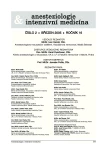-
Medical journals
- Career
Respiratory Care in the Czech Republic: a Multicenter Study
Authors: V. Černý 1; I. Herold 2; P. Dostál 1; V. Šrámek 3; I. Novák 4; Pracovní Skupina Sekce Intenzivní Medicíny Při České Společnosti Anesteziologie; Resuscitace; Intenzivní Medicíny
Authors‘ workplace: Klinika anesteziologie, resuscitace a intenzivní medicíny Univerzity Karlovy v Praze, Lékařské fakulta v Hradci Králové a Fakultní nemocnice Hradec Králové 1; Anesteziologicko-resuscitační oddělení Klaudiánovy nemocnice, Mladá Boleslav 2; Anesteziologicko-resuscitační klinika Masarykovy univerzity a Fakultní nemocnice u sv. Anny v Brně 3; Interní klinika Univerzity Karlovy v Praze, Lékařské fakulty v Plzni a Fakultní nemocnice Plzeň Seznam spolupracujících pracovišť je uveden na konci práce. 4
Published in: Anest. intenziv. Med., 16, 2005, č. 2, s. 105-111
Category: Intensive Care Medicine - Original Paper
Overview
Objective:
Survey of the level of respiratory care at Czech ICUs in 2004.Design:
Prospective multicentre one-day observational study using a questionnaire.Material and Methods:
Evaluation of responses to a questionnaire sent to members of Intensive Care Section of the Czech Society of Anaesthesiology and Intensive Care Medicine.Results:
Data from 70 ICUs with 570 beds were obtained. The mean length of ICU stay was 7.8 days. 407 patients were currently hospitalized (mean age 58 years). Out of 535 ventilators 60% were equipped with respiratory mechanics chart. Bronchoscopy is performed by intensivists in 51% ICUs, in 46% ICUs by other specialists. Blood gas analysis availability: 36% ICU have bedside analysators, 64% use the central lab. The chest X-ray and sonography available in 99% and 89% ICUs, respectively. CT availability within 30 minutes in 91% ICUs. The cuff pressure in tracheal cannula is measured in 73%, cannulas with supraglotic drainage are routinely used in 13% and selectively in 50% ICUs. The ventilatory circuit is most often changed in weekly intervals (34%). HME is used in 51%, HME with booster in 36% and an active humidification in 26% ICUs. Closed tracheal suction systems is routinely used in 40% and selectively in further 50% ICUs. The prone position is used in 66%, inhaled NO in 18%, HFV/HFO in 13%, recruiting manoeuvres in 54% ICUs. Surgical and percutaneous tracheotomies are used in 49% and 50% ICUs, respectively.
At the study day the mechanical ventilation was used in 248, non-invasive ventilatory support in 6 and oxygenotherapy in 138 patients (altogether 407 patients hospitalized). Most common indications for mechanical ventilation were the impairment of consciousness (26%) and postoperative care (26%). PCV (N = 88 cases) was used with following mean parameters: PIP 21 cmH2O, PEEP 7 cmH2O and FiO2 0.45. The mean setting of VCV (N = 54): Vt 7.8 ml/kg, PEEP 6 cmH2O and FiO2 0.48. In 106 cases other ventilatory modes were used. Tracheotomy was performed on the 8th day on average. SIMV with PS or PSV alone were mostoften used for weaning.
Conclusion:
Compared to the previous survey in 1999 increased number of admitted patients, patients requiring the mechanical ventilation, availability of selected diagnostic procedures, usage of the specialized care of airways and increase in percutaneous tracheotomies were detected.Key words:
mechanical ventilation – pulmonary mechanics – bronchoscopy – recruiting manoeuveres – tracheostomy – nitric oxide – prone position
Labels
Anaesthesiology, Resuscitation and Inten Intensive Care Medicine
Article was published inAnaesthesiology and Intensive Care Medicine

2005 Issue 2-
All articles in this issue
- A Single-shot Caudal Block with Clonidin for Hypospadia Repair in Children
- First Cases of Pulmonary Endarterectomy in the Czech Republic: a Case Report
- Respiratory Care in the Czech Republic: a Multicenter Study
- The Influence of Sodium Nitroprusside Administration on the Occurence and Abolishion of Vasospasms in Subarachnoid Haemorrhage: a Prospective Interventional Study
- Akútna otrava fluorokremičitanom sodným (Na2SiF6) – kazuistika
- Breathing Filters and Heat and Moisture Exchangers: Current Thinking Exposed!
- Anaesthesiology and Intensive Care Medicine
- Journal archive
- Current issue
- Online only
- About the journal
Most read in this issue- A Single-shot Caudal Block with Clonidin for Hypospadia Repair in Children
- First Cases of Pulmonary Endarterectomy in the Czech Republic: a Case Report
- Akútna otrava fluorokremičitanom sodným (Na2SiF6) – kazuistika
- Respiratory Care in the Czech Republic: a Multicenter Study
Login#ADS_BOTTOM_SCRIPTS#Forgotten passwordEnter the email address that you registered with. We will send you instructions on how to set a new password.
- Career

